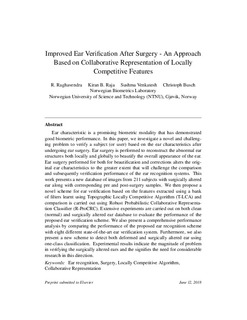| dc.contributor.author | Ramachandra, Raghavendra | |
| dc.contributor.author | Raja, Kiran | |
| dc.contributor.author | Venkatesh, Sushma Krupa | |
| dc.contributor.author | Busch, Christoph | |
| dc.date.accessioned | 2019-11-06T08:32:37Z | |
| dc.date.available | 2019-11-06T08:32:37Z | |
| dc.date.created | 2019-01-10T11:17:05Z | |
| dc.date.issued | 2018 | |
| dc.identifier.citation | Pattern Recognition. 2018, 83 416-429. | nb_NO |
| dc.identifier.issn | 0031-3203 | |
| dc.identifier.uri | http://hdl.handle.net/11250/2626788 | |
| dc.description.abstract | Ear characteristic is a promising biometric modality that has demonstrated good biometric performance. In this paper, we investigate a novel and challenging problem to verify a subject (or user) based on the ear characteristics after undergoing ear surgery. Ear surgery is performed to reconstruct the abnormal ear structures both locally and globally to beautify the overall appearance of the ear. Ear surgery performed for both for beautification and corrections alters the original ear characteristics to the greater extent that will challenge the comparison and subsequently verification performance of the ear recognition systems. This work presents a new database of images from 211 subjects with surgically altered ear along with corresponding pre and post-surgery samples. We then propose a novel scheme for ear verification based on the features extracted using a bank of filters learnt using Topographic Locally Competitive Algorithm (T-LCA) and comparison is carried out using Robust Probabilistic Collaborative Representation Classifier (R-ProCRC). Extensive experiments are carried out on both clean (normal) and surgically altered ear database to evaluate the performance of the proposed ear verification scheme. We also present a comprehensive performance analysis by comparing the performance of the proposed ear recognition scheme with eight different state-of-the-art ear verification system. Furthermore, we also present a new scheme to detect both deformed and surgically altered ear using one-class classification. Experimental results indicate the magnitude of problem in verifying the surgically altered ears and the signifies the need for considerable research in this direction. | nb_NO |
| dc.language.iso | eng | nb_NO |
| dc.publisher | Elsevier | nb_NO |
| dc.rights | Attribution-NonCommercial-NoDerivatives 4.0 Internasjonal | * |
| dc.rights.uri | http://creativecommons.org/licenses/by-nc-nd/4.0/deed.no | * |
| dc.title | Improved ear verification after surgery - An approach based on collaborative representation of locally competitive features | nb_NO |
| dc.type | Journal article | nb_NO |
| dc.type | Peer reviewed | nb_NO |
| dc.description.version | acceptedVersion | nb_NO |
| dc.source.pagenumber | 416-429 | nb_NO |
| dc.source.volume | 83 | nb_NO |
| dc.source.journal | Pattern Recognition | nb_NO |
| dc.identifier.doi | 10.1016/j.patcog.2018.06.008 | |
| dc.identifier.cristin | 1653893 | |
| dc.description.localcode | © 2018. This is the authors’ accepted and refereed manuscript to the article. Locked until 18.6.2020 due to copyright restrictions. This manuscript version is made available under the CC-BY-NC-ND 4.0 license http://creativecommons.org/licenses/by-nc-nd/4.0/ | nb_NO |
| cristin.unitcode | 194,63,30,0 | |
| cristin.unitname | Institutt for informasjonssikkerhet og kommunikasjonsteknologi | |
| cristin.ispublished | true | |
| cristin.fulltext | preprint | |
| cristin.qualitycode | 2 | |

